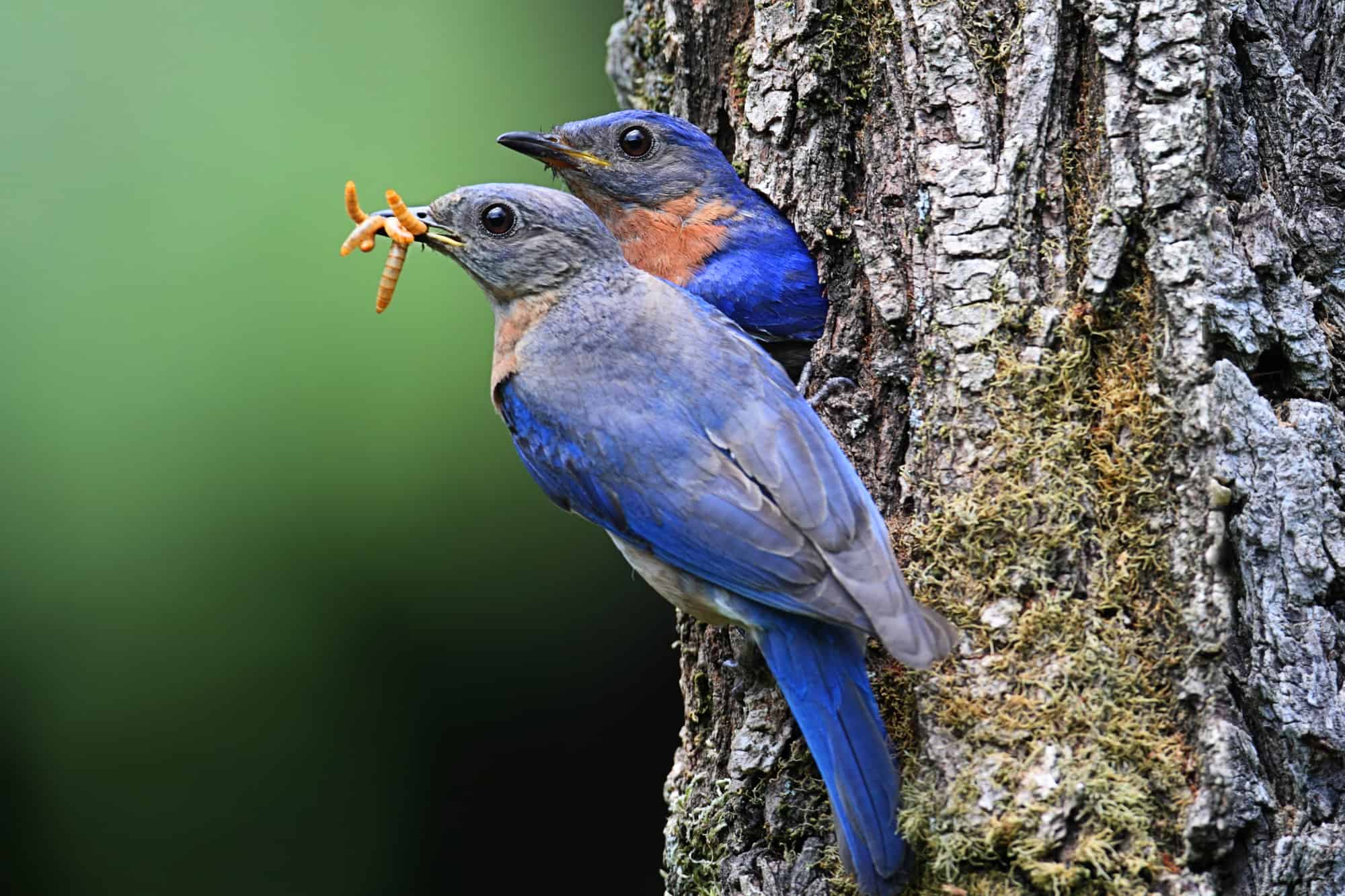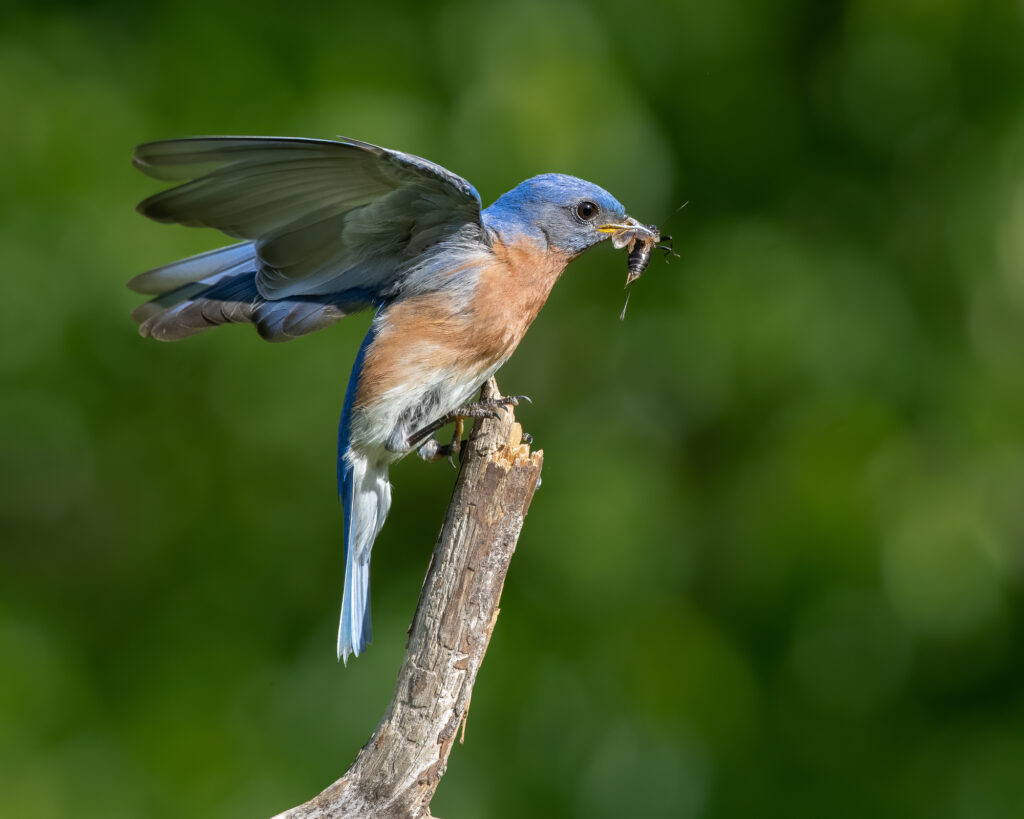Even if you put out bird feeders year after year, you may never see a bluebird stop by for a meal.
This is because all three bluebirds– the Eastern Bluebird, Western Bluebird, and Mountain Bluebird– are primarily insectivores, meaning they rely on a diet consisting mostly of insects and insect larvae. They aren’t likely to show up to a seed feeder like cardinals, finches, or other common backyard birds.
But just because you can’t get them to start eating seeds doesn’t mean you can’t lure them in!
Provide Mealworms

Bluebirds that visit backyard feeders typically visit for mealworms, which can be purchased either live or dried from your local farm and garden store or online.
- Kaytee Mealworms are an excellent, high-protein food source for many wild birds. They are a high-energy treat that will attract...
- Attract Bluebirds, Wrens, Robins, Chickadees, Woodpeckers and Cardinals
- Can be fed alone in a feeder or mixed with a favorited seed
Last update on 2024-07-26 / Affiliate links / Images from Amazon Product Advertising API
Mealworms are the larvae of darkling beetles. Though live food is certainly more appealing to most birds than dried food, many people opt for dried mealworms, which are considered more pleasant to humans since you don’t have to deal with live crawlers.
While you can just put mealworms in your standard bird feeders, many people opt for a bluebird-specific feeder that keeps larger birds out and keeps mealworms in. For our guide to some of the best bluebird feeders, click here.
You can also buy suet with mealworms in it, which can be especially interesting to bluebirds as temperatures dip and high-energy foods become more valuable.
- Attracts a variety of birds
- Good for feeding all year round
- Excellent variety and value for the money
Last update on 2024-07-26 / Affiliate links / Images from Amazon Product Advertising API
Mealworms are not the only thing that humans can use to interest bluebirds. They will also eat fruits such as raisins and blueberries and may also be tempted by scrambled eggs under severe conditions, according to the Michigan Bluebird Society.
Plant Native Plants

In the wild, bluebirds eat bugs like beetles, crickets, grasshoppers, worms, insect larvae, and other small targets.
With this in mind, planting native plants and allowing for a diverse backyard is one key way to draw more bluebirds to your yard.
Many people treat their yards for mosquitoes and other bugs, and while we might find these and other bugs annoying, they’re a key part of the diet for birds and other wildlife.
Frequently Asked Questions
What Won’t Bluebirds Eat?
First and foremost, bluebirds typically won’t eat most seeds that bring other birds in.
That’s not to say they won’t ever eat seeds. If times are lean, an available feeder filled with sunflower seeds is better than nothing.
They’re also not likely to be interested in peanuts, corn, oats, or many of the other foods that are of interest to blue jays, cardinals, sparrows, and other popular backyard songbirds.
How Do You Attract Bluebirds to Your Yard?
Like any bird, the key to attracting bluebirds to your yard lies in two main things: a safe, well-tailored habitat and food, which often go hand in hand.
Planting native plants can go a long way to creating a habitat that supports diverse species, including healthy insect populations that provide food for bluebirds and other birds. Additionally, you can provide supplemental food in the form of mealworms, a bluebird favorite.
If you have a dead tree on your property with holes in it that isn’t threatening people or property, you also might want to consider leaving it standing, as bluebirds nest in cavities.
Bluebirds are also known to use nesting boxes in place of traditional tree cavities, so putting up a bluebird nesting box is one more way you can potentially bring these colorful birds to your yard.
What Do Bluebirds Eat in the Winter?
In places where bugs can be found year-round, bluebirds’ diets don’t change too much in the winter months.
However, those that don’t make it too far south might have to shift slightly from their insect-based diet to a more fruit-centered one as the number of insects drops in colder temperatures.
What Do Bluebirds Drink?
While they get some moisture from their foods, all birds (and all living things) need water to survive.
Aside from providing food and shelter, setting up a bird bath filled with cool, fresh water in your yard is one way you can help the bluebirds.
What Do Baby Bluebirds Eat?
Bluebirds grow up eating softer versions of an adult bluebird’s diet. For the two-plus weeks that they’re in the nest, they rely on a steady dose of soft bugs like caterpillars and worms provided for them by mom and dad.
The North American Bluebird Society recommends live mealworms during the breeding season since dried mealworms don’t contain much moisture for baby birds. A little bit of water can help soften up dried mealworms.
Do Bluebirds Eat Fruit?
Bluebirds’ natural diet includes fruits such as berries, cherries, and grapes.
Since they’re not very large birds, if you’re serving up larger fruits for bluebirds, you may want to cut them into smaller pieces that they can handle more easily.
What Types of Insects Do Bluebirds Eat?
Bluebirds eat a variety of insects, including beetles, crickets, grasshoppers, mosquitoes, and more, as well as larvae from these and other bugs.
Other non-insect crawlers that could interest bluebirds include worms and spiders.

